The AMD Radeon R9 290 Review
by Ryan Smith on November 5, 2013 12:01 AM EST- Posted in
- GPUs
- AMD
- Radeon
- Hawaii
- Radeon 200
Power, Temperature, & Noise
As always, last but not least is our look at power, temperature, and noise. Next to price and performance of course, these are some of the most important aspects of a GPU, due in large part to the impact of noise. All things considered, a loud card is undesirable unless there’s a sufficiently good reason – or sufficiently good performance – to ignore the noise.
As we alluded to in our look at the 290’s build quality and AMD’s last minute specification change, while the 290 has great performance under the complete range of our gaming benchmarks, it’s with power, temperature, and noise that it has to pay the piper for that performance. There’s no getting around the fact that 47% on the 290 series reference cooler is going to be loud, and in this section we’ll break down those numbers and attempt to explain why that is.
First, let’s start with voltages. Ideally we’d use VIDs here, but due to the fact that none of our regular tools can read AMD’s VIDs for the 290 series, we’re left with what works. And what works is GPU-Z, which can read the VDDC coming off of the IR 3567B controller. These aren’t “perfect” numbers as we don’t have the ability to factor out fluctuations due to temperature or the impact of vDroop, but they’ll work in a pinch.
| Radeon R9 290 Series Voltages (VDDC/GPU-Z) | ||||
| Ref. 290X Boost Voltage | Ref. 290 Boost Voltage | Ref. 290 Base Voltage | ||
| 1.11v | 1.18v | 1.14v | ||
To that end you can immediately see that the 290 starts off in a weakened position relative to the 290X. Second tier products are a mixed bag in this regard as sometimes they’ll be composed solely of chips with damaged functional units that can be shut off and then downclocked to operate at a lower voltage, while in other cases they’ll also include chips that have worse leakage and power consumption characteristics. In the case of the 290 we have the latter.
As such the 290 is operating at a higher voltage than the 290X at both the base GPU clockspeed of 662Mhz, and the boost GPU clockspeed of 947MHz. This means at any given clockspeed the GPU on the 290 is going to be drawing more power – likely more than enough to offset the reduction from the disabled CUs – and furthermore we’re seeing that the voltage reduction from operating at lower voltages is not very significant. If these results are reasonably accurate then this means that the power costs of ramping up the clockspeed are relatively cheap, but the power savings of throttling down are relatively sparse. The GTX Titan, by comparison, sees a full 100mv decrease going from 940MHz to 836Mhz.
Having established that, we can see why AMD’s 7% fan speed increase had such a large impact on performance. Even a bit more cooling allows the card to jump to far higher clockspeeds, which significantly improves performance. With a fan speed of 47% the 290 has enough cooling to sustain 947MHz across everything except the TDP limited FurMark and Company of Heroes 2.
| Radeon R9 290 Average Clockspeeds | |||
| 47% Fan (New Default) | |||
| Boost Clock | 947MHz | ||
| Metro: LL |
947MHz
|
||
| CoH2 |
930MHz
|
||
| Bioshock |
947MHz
|
||
| Battlefield 3 |
947MHz
|
||
| Crysis 3 |
947MHz
|
||
| Crysis: Warhead |
947MHz
|
||
| TW: Rome 2 |
947MHz
|
||
| Hitman |
947MHz
|
||
| GRID 2 |
947MHz
|
||
With that out of the way, let’s dive into power, temperatures, and noise.
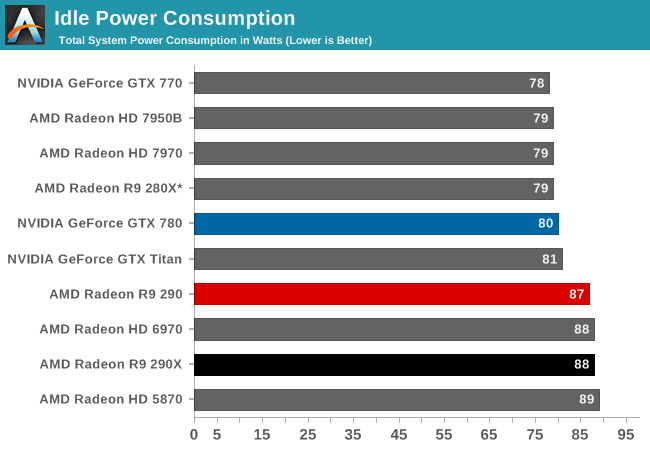
Idle power is essentially unchanged from the 290X. The 16 GDDR5 memory chips aren’t doing AMD any favors, but more significantly they appear to still have a power leak in their drivers at idle. Until they fix that, the 290 series will draw several watts more than any other modern single-GPU card.
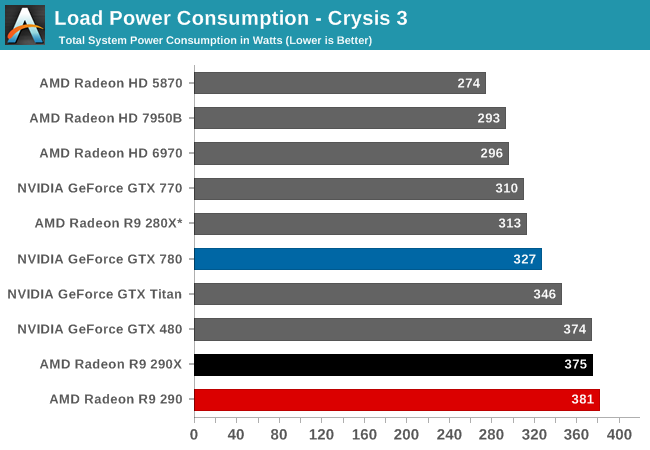
Moving on to power consumption under Crysis 3, we can see just how AMD’s TDP hasn’t changed compared to the 290X. In fact because these cards are effectively tied in performance in this game, we can even see at least some of the impact of the 290’s higher voltages. By operating at higher voltages in general, and then furthermore higher clockspeeds (requiring higher voltages), the 290 draws just a wee bit more power than the 290X under our gaming workload. Power efficiency wasn’t AMD’s strongest hand to behind with on 290X, and 290 makes it just a bit worse.
This also means that the 290 isn’t competitive with the GTX 780 on the matter of power consumption and power efficiency in general. A 54W difference at the wall for identical performance in Crysis 3 – or extrapolated over our complete benchmark suite a performance advantage of 6% – is very difficult to swallow. As with everything else to come for power, temp, and noise, the GTX 780 has a very real advantage here.
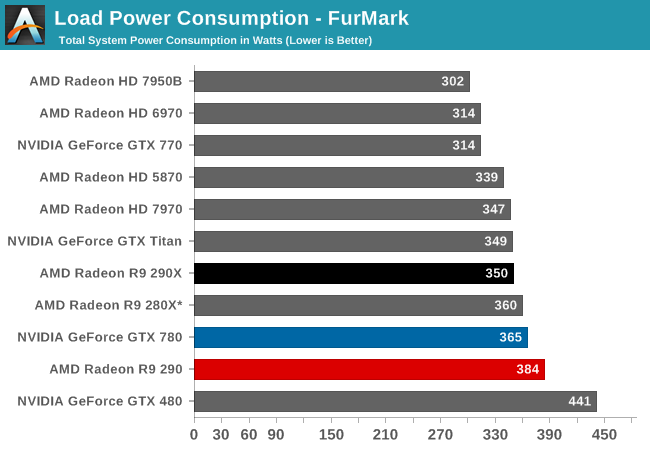
Moving on to FurMark, despite the fact that we should be TDP limited the 290 actually draws more power than the 290X. To be frank we’re at a bit of a loss on this one; 290 bottoms out at 662MHz here, so it may be that we’re seeing one of the things the card can do to try to maintain its base clockspeed. Alternatively this may be the voltage effect amplified. Regardless of the reason though it’s a very repeatable scenario, and it’s a scenario that has 290 drawing 34W more at the wall than 290X.
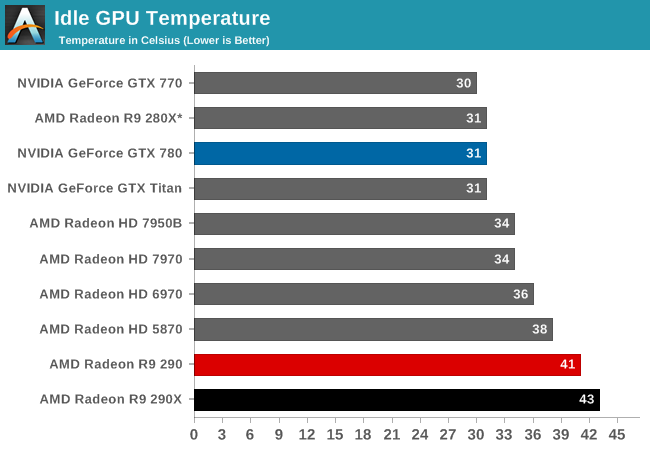
Given the fact that the 290 and 290X are built on identical boards, the idle temperatures are consistent, if not a bit more spread out than usual. Until AMD gets their power leak under control, Hawaii isn’t going to come down below 40C at idle with the reference cooler.
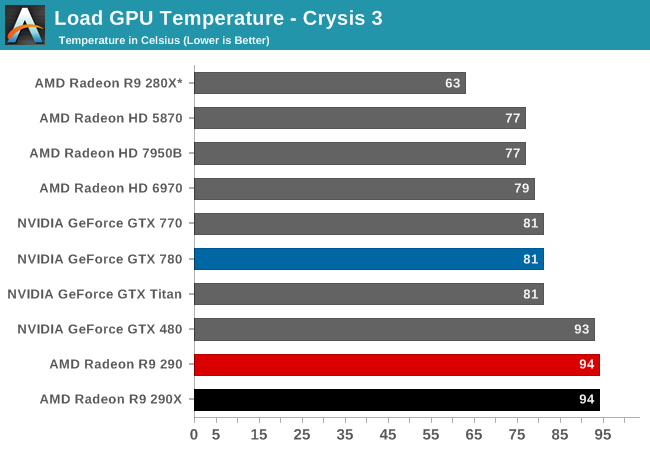
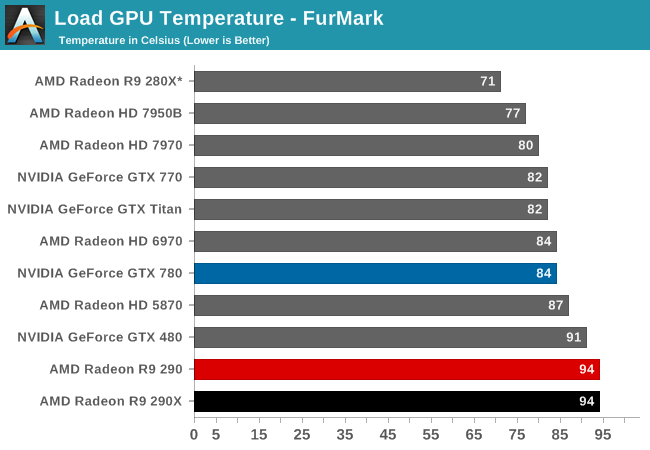
Due to the mechanisms of PowerTune on the 290 series, the sustained load temperatures for the 290 and 290X are a very consistent 94C. As we laid out in our review of the 290X these temperatures are not a problem so long as AMD properly accounts for them in their power consumption projections and longevity projections. But coming from earlier cards it does take some getting used to.
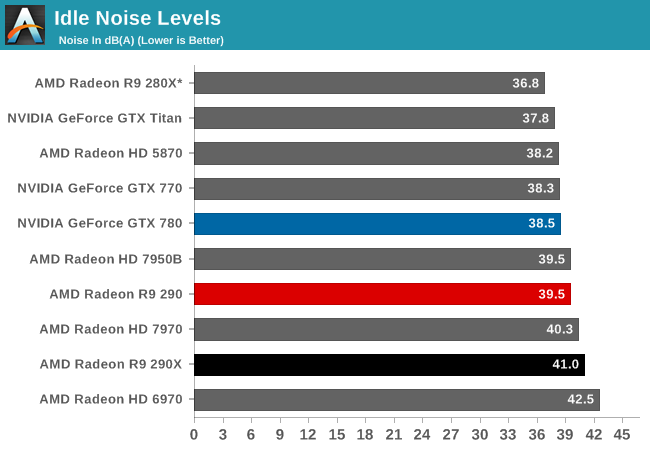
At last we have our look at noise. Starting with idle noise, we can see that the 290 actually outperforms the 290X to a meaningful degree, squeaking under the 40dB mark. The fact that these cards utilize the same cooler operating at the same fan speed means that these results caught us off guard at first, but our 290 sample for whatever reason seems to be slightly better built than our 290X sample. These results match what our ears say, which is that the 290X has a bit of a grind to it that’s not present on the 290, and consequently the 290 is that much quieter.
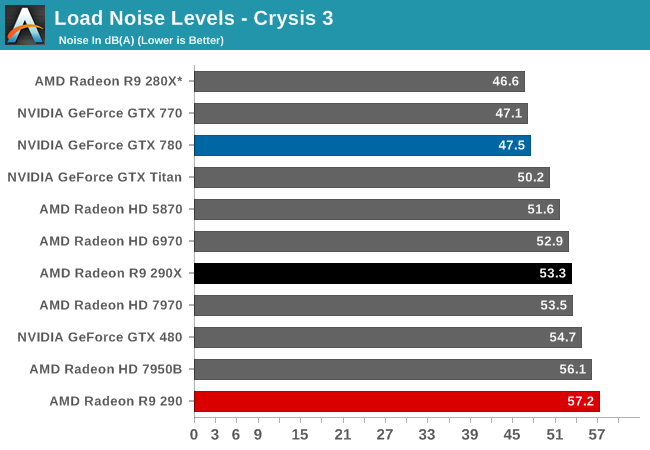
Our Crysis 3 noise chart is something that words almost don’t do justice for. It’s something that needs to be looked at and allowed to sink in for a moment.
With the 290 AMD has thrown out any kind of reasonable noise parameters, instead choosing to chase performance and price above everything else. As a result at 57.2dB the 290 is the loudest single-GPU card in our current collection of results. It’s louder than 290X (a card that was already at the limit for reasonable), it’s louder than the 7970 Boost (an odd card that operated at too high a voltage and thankfully never saw a retail reference release), and it’s 2.5dB louder than the GTX 480, the benchmark for loud cards. Even GTX 700 series SLI setups aren’t this loud, and that’s a pair of cards.
At the end of the day the 290 is 9.7dB louder than its intended competition, the GTX 780. With a 10dB difference representing a two-fold increase in noise on a human perceptual basis, the 290 is essentially twice as loud as the GTX 780. It’s $100 cheaper and 6% faster, but all of that comes at the very high price of twice the noise.
Everyone’s cutoff for a reasonable noise level for a single-GPU card is going to be different. Ours happens to be the 7970, which on our latest testbed measures in at 53.5dB. To that end the 290 is 3.7dB louder, putting it well past what we’d consider to be reasonable for the 290. It’s a powerful card, but these noise levels are unreasonable and unacceptable for any scenario that involves being able to hear the card while it’s working.
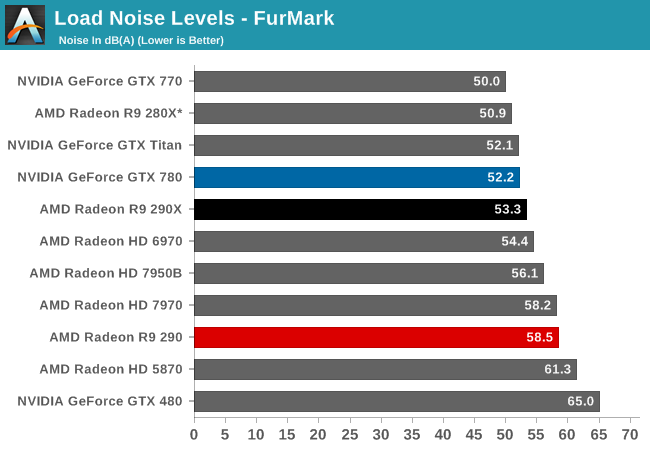
Finally we’ll look at noise under FurMark. As loud as the 290 is under Crysis 3, the 290 was only pushed to 45% fan speed under that workload. Under FurMark the 290 ratchets up to 47% and to its peak noise level of 58.5dB. Now to the credit of the 290 this does end up being better than the 5870 and GTX 480, but as neither of those cards implements modern power throttling technology it’s at best an unfair fight. Compared to any card with power throttling, the 290 ends up once more being the worst.
Wrapping things up, the power/temp/noise situation for the 290 is rather straightforward, but unfortunately for AMD it’s not going to be in their favor. 290 is at least marginally more power hungry and quite a bit louder than 290X, never mind GTX 780. As we’ve seen in previous pages the performance is quite good, but it comes at what will in most cases be a very high cost.
Finally, since we had a bit more time to prepare for the 290 review than we did the 290X review, we used part of our time to investigate something we didn’t get to do with the 290X: what would performance look like if we equalized for noise? Earlier in this article we took at brief look at performance if we equalized for noise against the 290X – the performance hit is about 12% - but how would the 290 fare if it were equalized to the GTX 780?
The answer is not well, likely for the voltage matters we discovered earlier in this article. To get a 290 down to ~48dB requires reducing the maximum fan speed to 34%, which is something AMD’s software allows. The problem is that at 34% the effective cooling level on the 290 is so poor that even after dropping to the base GPU clockspeed of 662MHz it still generates too much heat, requiring it to ramp up the fan speed to compensate. In other words it’s simply impossible to get the 290 to match the GTX 780’s noise levels under load. Based on our data the 290 requires a minimum fan speed of 38% to maintain its base clockspeed under sustained load, which pushes noise levels out from a GTX 780-like 48dB to a GTX Titan-like 50.9dB.
With that in mind, we went ahead and ran a selection of our benchmarks with the 34% maximum fan speed. The performance hit, as you’d expect, is significant.
| Radeon R9 290 Average Clockspeeds | |||||
| 47% Fan | 40% Fan | 34% Fan | |||
| Boost Clock | 947MHz | 947MHz | 947MHz | ||
| Metro: LL |
947MHz
|
830MHz
|
662MHz
|
||
| Battlefield 3 |
947MHz
|
870MHz
|
662MHz
|
||
| Crysis 3 |
947MHz
|
720MHz
|
662MHz
|
||
| Crysis: Warhead |
947MHz
|
662MHz
|
662MHz
|
||
| TW: Rome 2 |
947MHz
|
761MHz
|
662MHz
|
||
| GRID 2 |
947MHz
|
825MHz
|
700MHz
|
||

| Radeon R9 290 Relative Performance | ||||
| 290: 47% Fan Speed (Default) | 290: 40% Fan Speed | 290: ~34% Fan Speed | ||
| 100% | 88% | 78% | ||
To get down to the 34%-38% fan speed range, the 290 has to shed an average of 22% of its performance, peaking under a few titles at 25%. To be sure this makes the card much quieter – though not as quiet as a GTX 780 – but it also sacrifices much of the 290’s performance advantage in the process. At this point we’ve essentially reduced it to a 280X.
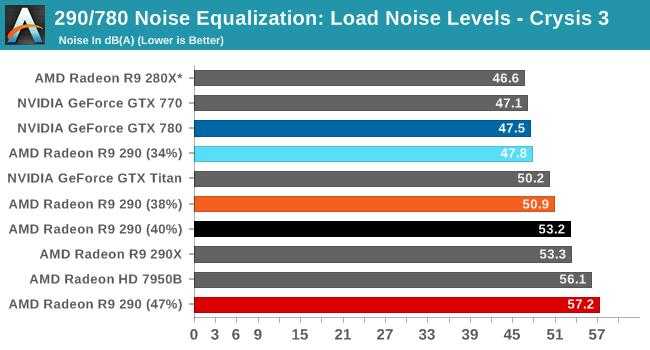
Looking at the resulting noise levels, you can see the full outcome of our tweaks. If we could sustain 34% we’d have a noise level consistently close to that of the GTX 780, but instead under Crysis 3 and a couple other games fan speeds level out at 38%, pushing noise levels to 50.9dB and placing them a bit higher than GTX Titan.
Based on this data it’s safe to say that the performance cost for using the fan control function to reduce the fan noise on the 290 will be moderate to severe. You can’t match GTX 780 or even GTX Titan, and doing so will reduce performance to that of a 280X. 40% on the other hand is more viable, but keep in mind we’re now at 290X noise levels for roughly 85% of the 290X’s performance, which isn’t a great outcome either.










295 Comments
View All Comments
swing848 - Tuesday, November 5, 2013 - link
It will only get loud for me when playing games or the occasional benchmark. During games I weara headset, and during benchmarks I can leave the room. I have a room dedicated to computer use
and the house has good sound proofing, so, it will not bother other people.
If I want it quiet I will use a water cooler with a large radiator and fan, my Cooler Master HAF
922 case already has sealed holes for tubing for an external radiator.
Water cooling is better than dumping all the hot air from the video card into my case, even if it
is well cooled with 200mm fans. I overclock my CPU and I do not want it, RAM, or chips on the
motherboard to get any hotter than necessary.
The only thing I will miss on this card are Black Diamond Chokes and Digital Power 8+2+2 phase
used on the Sapphire R9 280X Toxic [Black Diamond Chokes are also used on Sapphire R9 280 Vapor-
X]. To be honest I do not know how many mosfits are dedicated to cool GPU functions on the R9
290. In any event, both the Toxic and Vapor-X dump hot air into the case.
Another thing I would like to have seen on the Sapphire R9 290 is a metal back plate.
somethingwicked - Tuesday, November 5, 2013 - link
what the holy gee whizthe new AMD drivers are insane! 290x is speeding past Titan now and 780 is a turtle while 290x is a ferrari... the new 290 is performing like the 290x was at launch and now the 290x is a card unto its self at the top of the food chain
thank goodness for competition
i smell more deep nvidia price cuts cause AMD is kicking butt
TheJian - Tuesday, November 5, 2013 - link
rofl. So NV just has to release a "fan that drives you out of the room" driver now to respond. IF NV did this all of you would be falling all over yourselves to moan and groan claiming NV was cheating. AMD does it, and wow this is awesome, I love the noise anyway...LOL. Technically this is all NV has to do though right? Raise the fan speed until it hits another 10DB's and blow them down again.Perf is great, but not if it drives me out of my room. There is nothing stopping NV from adding 10DB's to their cards and calling it a day. But I don't want this being called normal. IMHO this is a crap way to get perf and a game both sides can play. If NV does this tomorrow and says we're hiking prices because if we overclock our cards also (which is essentially what they're doing here, just reverse, raise fan so clocks boost higher, same story) we blow AMD away.
https://www.youtube.com/watch?v=djvZaHHU4I8
Both cards clocked to max (290x vx. 780, NOT TI mind you).
Fast forward to 8:40 for benchmarks...AMD is blown away. The 780 didn't lose ANY game. Not one. And in star citizen blows AMD away. I don't believe these cards will be used mostly on 1600P or 1440p either. 1080/1200p is running on 98.5% of our screens and a large portion of the 1.5% that is above these two resolutions are running TWO or more cards. Steam's surveys don't lie. Already they turn down nearly every game at 1440p here which to me means you won't run there anyway (they are not reporting mins here for most games). Everything is pretty maxed in linustechtips vid above at 1080p, and you should be able to stay above 30fps (probably?) doing it. They are reporting avg's here at anandtech and already turning stuff down. Meaning maxing graphics on a lot of games would be unplayable under 30fps especially when lots of crap is going on. LOW DETAIL? Seriously? So Ryan is assuming you'll buy one of these cards (or any single gpu card) to then go out and buy a 1440p monitor (which are still over $550 for any brand you'd recognize the name of on newegg, and start there when you choose NEWEGG ONLY) and then run the details on low to play games? I don't think so. If he's assuming we're all going to buy new monitors, might as well get Gsync instead (though I'd say wait for more models first even if Asus has a decent one out of the gate). Heck some of the games have details DOWN on 1080p here (total war2, medium shadows? still looks like it would hit below 30fps on most cards).
For anyone saying get a water block...LOL. How much did my card cost if I have to add that and how many regular users even know what water is or are even capable of adding one? I say that as a guy who has as Koolance kit. Or even adding an aftermarket fan. Isn't this upping the cost of the card then?
Both solutions are unacceptable and attempting to fix a problem caused by shipping a card that already is unacceptably NOISY, hot and sucking up watts vs. it's competition. No games either.
Add on top reviews elsewhere show other games that give an opposite story. Techpowerup, Techspot, Guru3d, Hardocp show wins for AC3, COD Blackops2, Diablo3 (spanked by NV), FarCry3, SplinterCell Blacklist, Star Craft2 (spanked, heck 770 does well), World of Warcraft (spanked), Skyrim (lost 3 resolutions, 290/x won 1600p, oddly lost upping to 5760), Resident Evil 6.
So maybe you need to take a bit of a WIDER view than anandtech ;) I don't call 53 more watts than 780 (or 70 more than 770) a victory. Never mind the noise it creates while doing it. Is running 10DB's higher really a better card? Do people here realize that noise in DB's is EXPONENTIAL? A 10Db noise difference is HUGE (ryan did say 2x as loud). 12 degress hotter for this kind of perf isn't good either. I see a clear reason NV should be charging more than AMD's cards. They are better. I can OC and beat them easily without all the noise, heat, watts. I don't need a waterblock to do this either...ROFL. Whatever I already have on my card can do this easily and come in UNDER Ryan's 7970 noise levels that he calls acceptable.
I see no price cuts, but probably a few more videos poking fun at AMD like this:
https://www.youtube.com/watch?v=oV5vs27wnCA
Tell me that isn't funny ;) I'm wondering if someone at NV paid for this vid to be made...LOL. Sparks, dripping fire, ROFL. Great job of getting the message across.
rviswas11 - Tuesday, November 5, 2013 - link
i couldn't give two s***ts because when i game i wear noise cancelling headphones that i use for listening to music on the busrviswas11 - Tuesday, November 5, 2013 - link
so i'm happy. and with the exception of skyrim i could set the graphics card to 10% fan profile and max the game. i run quite afew mods for skyrim don't play it anymore.but i can see how the noise can be a major issue for a lot of people.
Morawka - Tuesday, November 5, 2013 - link
your not understanding. At this level of noise, not even noise canceling headphones will drown it out. This is louder than a 747 jet from 100 meters away.mgl888 - Tuesday, November 5, 2013 - link
You'd better be trolling.60dB is the intensity of a normal conversation.
Galidou - Tuesday, November 5, 2013 - link
Comon, a 747 jet 100 meters away... you gotta be freaking stupid to only think it could be true :Oahlan - Saturday, November 9, 2013 - link
@GalidouWhat do expect from nvidia fantards who think higher price is better.
They are so unsecure and delusional that they comment in every AMD review...
Nvidia is loving their stupidness...
1Angelreloaded - Saturday, November 16, 2013 - link
120 decibels is a 747 I would know I work around them, But AMDs new cards are crap, 550$ to add a water cooling system totaling around 200-300$.......either way its not a deal really, Nvidia cards have more headroom on air and water, while AMD's cards are impressive to an extent Hawaii is a bastard step child of sorts, it is probably a failed version of the next chip to compete with Maxwell but had no choice but to release it.